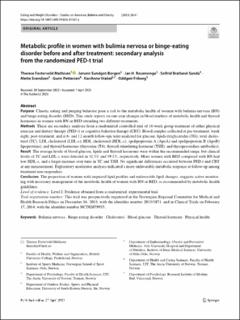| dc.contributor.author | Mathisen, Therese Fostervold | |
| dc.contributor.author | Sundgot-Borgen, Jorunn | |
| dc.contributor.author | Rosenvinge, Jan H | |
| dc.contributor.author | Bratland-Sanda, Solfrid | |
| dc.contributor.author | Svendsen, Mette | |
| dc.contributor.author | Pettersen, Gunn | |
| dc.contributor.author | Vrabel, KariAnne | |
| dc.contributor.author | Friborg, Oddgeir | |
| dc.date.accessioned | 2023-07-25T21:34:28Z | |
| dc.date.available | 2023-07-25T21:34:28Z | |
| dc.date.created | 2023-04-27T19:12:14Z | |
| dc.date.issued | 2023 | |
| dc.identifier.citation | Eating and Weight Disorders. 2023, 28, Atrikkel 41. | en_US |
| dc.identifier.issn | 1124-4909 | |
| dc.identifier.uri | https://hdl.handle.net/11250/3081376 | |
| dc.description.abstract | Purpose: Chaotic eating and purging behavior pose a risk to the metabolic health of women with bulimia nervosa (BN) and binge-eating disorder (BED). This study reports on one-year changes in blood markers of metabolic health and thyroid hormones in women with BN or BED attending two different treatments. Methods: These are secondary analyses from a randomized controlled trial of 16-week group treatment of either physical exercise and dietary therapy (PED-t) or cognitive behavior therapy (CBT). Blood samples collected at pre-treatment, week eight, post-treatment, and at 6- and 12-month follow-ups were analyzed for glucose, lipids (triglycerides (TG), total cholesterol (TC), LDL cholesterol (LDL-c), HDL cholesterol (HDL-c), apolipoprotein A (ApoA) and apolipoprotein B (ApoB) lipoproteins), and thyroid hormones (thyroxine (T4), thyroid stimulating hormone (TSH), and thyroperoxidase antibodies). Result: The average levels of blood glucose, lipids and thyroid hormones were within the recommended range, but clinical levels of TC and LDL-c were detected in 32.5% and 39.1%, respectively. More women with BED compared with BN had low HDL-c, and a larger increase over time in TC and TSH. No significant differences occurred between PED-t and CBT at any measurement. Exploratory moderator analyses indicated a more unfavorable metabolic response at follow-up among treatment non-responders. Conclusion: The proportion of women with impaired lipid profiles and unfavorable lipid changes, suggests active monitoring with necessary management of the metabolic health of women with BN or BED, as recommended by metabolic health guidelines. | en_US |
| dc.language.iso | eng | en_US |
| dc.publisher | Springer Nature | en_US |
| dc.relation.uri | https://link.springer.com/article/10.1007/s40519-023-01567-y | |
| dc.rights | Navngivelse 4.0 Internasjonal | * |
| dc.rights.uri | http://creativecommons.org/licenses/by/4.0/deed.no | * |
| dc.subject | binge-eating disorder | en_US |
| dc.subject | cholesterol | en_US |
| dc.subject | blood glucose | en_US |
| dc.subject | thyroid hormone | en_US |
| dc.subject | physical health | en_US |
| dc.subject | bulimia nervosa | en_US |
| dc.title | Metabolic profile in women with bulimia nervosa or binge-eating disorder before and after treatment: secondary analysis from the randomized PED-t trial | en_US |
| dc.type | Peer reviewed | en_US |
| dc.type | Journal article | en_US |
| dc.description.version | publishedVersion | en_US |
| dc.subject.nsi | VDP::Medisinske Fag: 700::Klinisk medisinske fag: 750::Psykiatri, barnepsykiatri: 757 | en_US |
| dc.source.volume | 28 | en_US |
| dc.source.journal | Eating and Weight Disorders | en_US |
| dc.identifier.doi | 10.1007/s40519-023-01567-y | |
| dc.identifier.cristin | 2143988 | |
| dc.source.articlenumber | 41 | en_US |
| cristin.ispublished | true | |
| cristin.fulltext | original | |
| cristin.qualitycode | 1 | |

